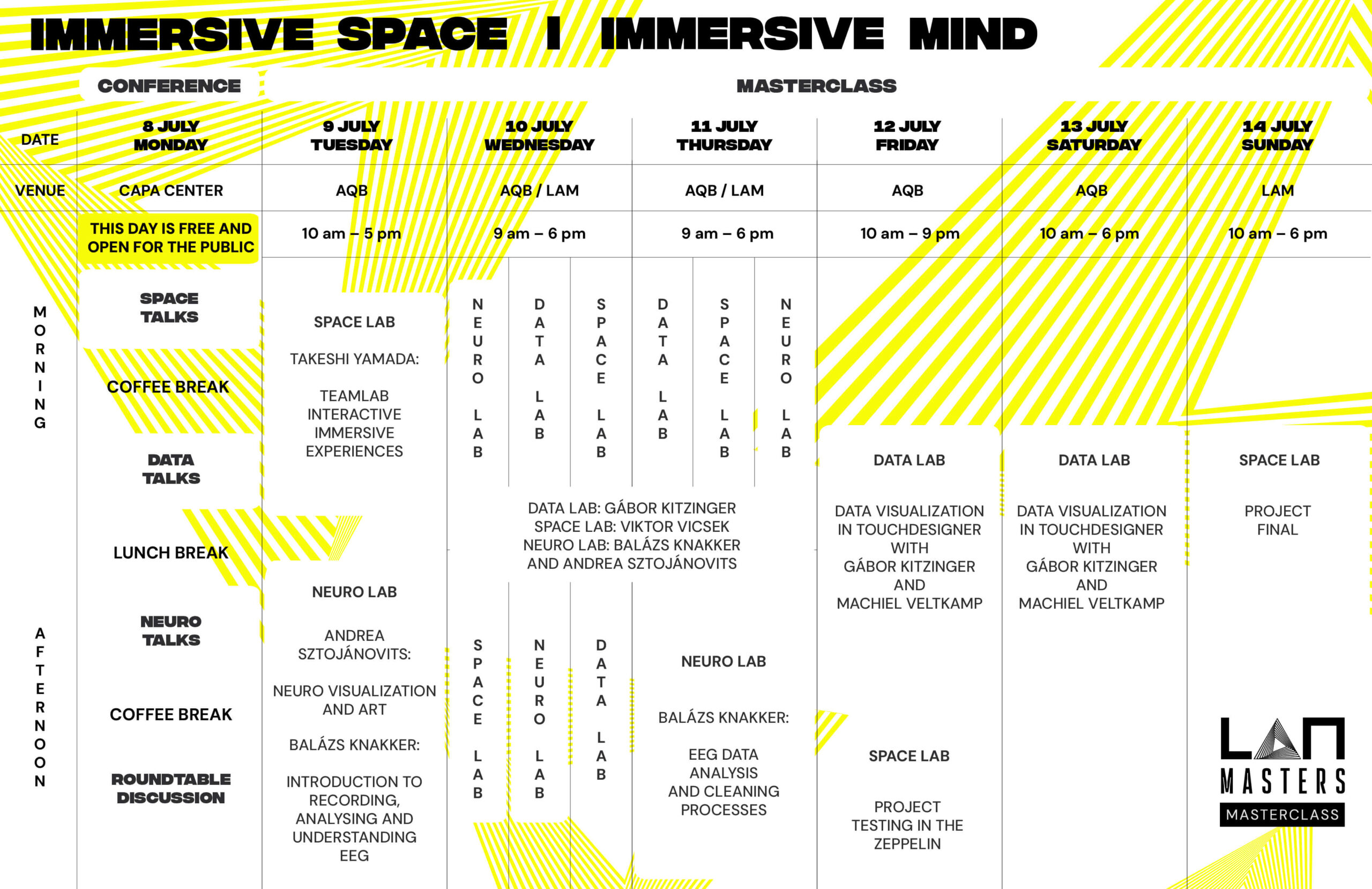MASTERCLASS WORKSHOP
MASTERCLASS WORKSHOP
MASTERCLASS WORKSHOP
MASTERCLASS WORKSHOP
MASTERCLASS WORKSHOP
MASTERCLASS WORKSHOP
IMMERSIVE SPACE | IMMERSIVE MIND INTENSIVE PRACTICE-BASED MASTERCLASS
9-14 JULY 2024
SPACE LAB | NEURO LAB | DATA LAB
VENUE.
THIS PROGRAM IS JUST FOR THE APPLICANTS
In LAM Masters Summer Masterclass vol I, we will create a 3-dimensional projected space in a unique, zeppelin-shaped installation, based on data visualization of the participants’ brain activity.
The masterclass will consist of three sections: NEURO LAB, DATA LAB and SPACE LAB.
NEURO LAB
In the NEURO LAB section, we will focus on understanding and processing neural signals, which in digital art terms, reveals a data set of our brain signals obtained by EEG in a creative, subjective visual interpretation. The EEG recording and analysis are parts of the process. The leader of this section is Balázs Knakker (HU) neurobiologist. Andrea Sztojánovits (HU), artist, will assist in the visual artistic interpretation of the process.
DATA LAB
In the DATA LAB part, guided by media artist Gábor Kitzinger (HU) and Machiel Veltkamp (NL), new media artist and creative coder, using the TouchDesigner software, participants visualize their recorded and analyzed EEG signals.
SPACE LAB
The SPACE LAB section will have two parts.
In the first part, Takeshi Yamada from teamLab (JP) will talk about their art in immersive spaces.
In the second part of SPACE LAB, light artist Viktor Vicsek (HU) will explain the 3D construction, optical mapping and the 3D composition strategies of the special zeppelin-shaped space.
In this course we used an Xon headset provided by Brain Products to record the EEG data that was the basis of the artistic process.
INSTRUCTORS
LAM MASTERS MASTERCLASS VOL I.
Takeshi YAMADA (JP) was born and raised in Tokyo in 1990.He studied at Durham University for one year and then graduated from Teikyo University in 2012 with a B.A. in English Literature and History. After working as an Marketing Manager in a travel industry in Zurich, he returned to Japan to work at teamLab where he is now the Director of Community Engagement.
Machiel Veltkamp (NL) is a Dutch new media artist and creative coder. He works as a researcher and developer at the Creative Technology Innovation Program at HKU. Additionally, he teaches at the Design for Change and Innovation program at the School for Creative Transformation. He teaches subjects such as Creative Coding, Interactive Systems, and The World and Its Systems.
Balázs Knakker (HU) is a neuroscientist studying how behaviour and cognition are forged in the brain – with non-invasive methods, from a computational and evolutionary perspective. During his PhD, he studied the role of alpha oscillations in the EEG in attention and short-term memory for complex visual objects like printed words or faces. Currently as a postdoctoral researcher at the University of Pécs he studies the neurochemical processes and evolutionary roots of human memory and attention.
Andrea Sztojánovits (HU) was VJing at techno parties and has been working on real-time audiovisual installations since 2001, she got her Doctorate Degree in 2019 at the Hungarian University of Fine Arts with her dissertation ‘VJing as a method’. Besides her creative work she is a lecturer at the Intermedia department at the Hungarian University of Fine Arts. Her main educational and research fields are visual music and meditation/chill spaces.
Gábor Kitzinger (HU) has established his reputation through the synthesis of art, audiovisual culture, and technology. His work in the 3D animation and video mapping scene began in the early 2000s with VJ performances at large-scale underground technoculture events. Joining the pioneering light art group, the Glowing Bulbs, he designed several large-scale building projections and delivered numerous AV performances around the world. His most recent sculptural works consist of interactive pseudo-holographic constructions. His research focuses on autonomous narratives using data and artificial neural networks.
Viktor Vicsek (HU): Limelight Co-Founder and artist Viktor Vicsek started out as a VJ in one of the first VJ communities of Hungary in 2000. He worked as the lead software developer for the Media Technology Group of the Hungarian National Academy’s Computer and Automation Institute between 2006 and 2011. Viktor participated in creating numerous art installations, theater, and contemporary dance plays as interaction designer/developer. Since 2011, he has been mostly active in creating content for architectural and 3D object projection mapping. He has been working with light and projection for most of the last 20+ years, from making slides for Pani projectors in the late 90s through designing numerous projected stage-sets for theater and interactive projection for dance performances to 3D animation for projection mapping.


